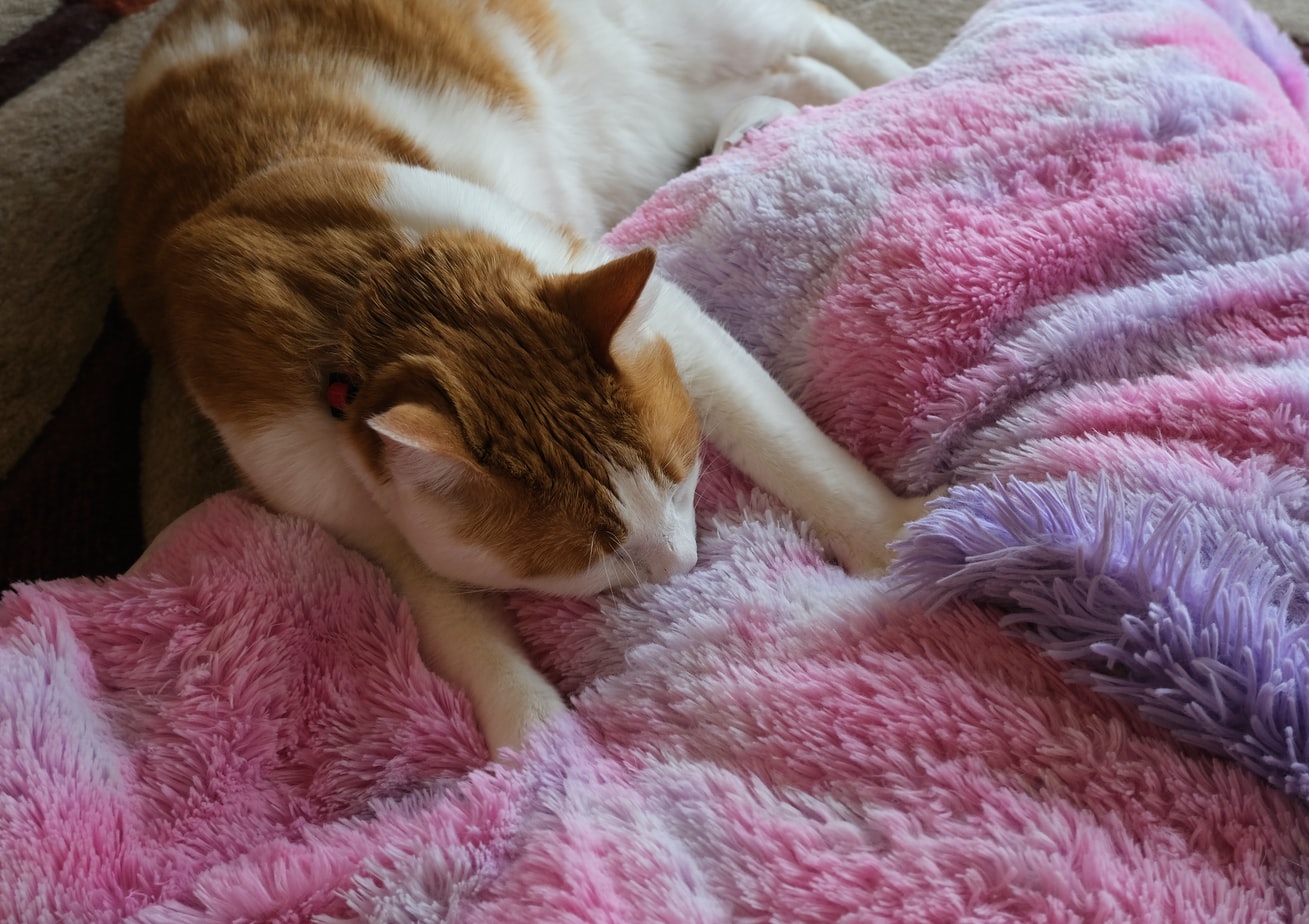Polyester items like clothing are present in our lives daily. This fabric is easy to maintain, it is lightweight and quite handy. No wonder that blankets made of it became so popular!
However, when being used frequently, they soon tend to lose their softness, and that is what disappoints their owners a lot. Want to know how to revive your favorite polyester blanket and make it soft as a feather? We know several tricks that can help you out with that!
How to Make Polyester Blankets Soft
Several methods exist of how to return that softness to your polyester cover again and make it pleasant to the touch. Each of them differs from another because of different supplies needed, and besides, not all the approaches will ask for actual washing.
Covers and throws made of polyester and soft and warm, and this is what we all love them for, but of course, they stand quite far away from those soft fluffy blankets with long hair that are pretty hard to take care of.
Nevertheless, it is a common request from the owners of polyester items about what they can do to revive the softness of their blankets and throws after prolonged use. Well, we can suggest a couple of alternatives:
How to make a blanket softer in the washing machine?
To bring your soft throw blankets back to life, the simplest and the quickest way is to launder them. But the trick is that you will need to add a magical ingredient to the wash for a miracle to happen, and that ingredient is white vinegar.

- What you need to do is to get the blanket ready, and set the machine at the gentle and low-temperature regime.
- The next step is to properly shake the blanket and even scrutinize it. Like that, you will make sure that no more debris is left somewhere in the folds or in the fluff.
- Now pour the amount of detergent needed for laundering polyester, and add white acetum to the same compartment.
- Shove the blanket into the barrel, and if you have other polyester items to be washed, add them as well, but only if those are of the same color! See, running the laundering machine several times in a row can make your bills quite high. So when washing all at once, you can significantly save money and time.
After you press the start button, it will only be left to wait until the laundering is done. During the wash, vinegar will do its job and return softness to the polyester blankets. You see, this natural liquid has the ability to loosen the fibers thus allowing the washing product to work better and delete the dirt and soil from the fabric.
It may indeed be needed to rinse the load two times since vinegar has quite a strong scent that is not always washed away after the first time. But that is completely fine, after the repeated rinsing, your blankets will have no extraneous smell.
It is better to dry polyester blankets and throws on the drying rack or the clothesline, and of course, wait until it is completely dry through.
We would even advise placing a dehumidifier into your cabinet where the blankets are kept to ensure they will remain the same fresh and dry.
How to make a blanket soft by the manual wash?

We agree that almost nobody uses this method today, but anything can happen, besides, the blanket may have some delicate decorations like embroidery or beading that will most likely get ruined in the laundering barrel. So to keep it safe, it is better to opt for such an old-fashioned way.
- Prepare the detergent, some white vinegar, the basin, and the hose.
- Start with shaking the blanket to ensure it is free from dirt and debris.
- Put the required amount of laundering product into the basin (feel free to use either powdered or liquid one), and add some vinegar to it.
- Now attach the hose to the faucet, and fill the basin with water. You want to fill it up to half or about three-quarters of its capacity. If there is more water, it may spill when the blanket is immersed in the basin.
- When there is enough aqua, swish it to dissolve the cleaning solution, and submerge the blanket for ten to fifteen minutes. See, soaking will allow acetum to do its magic and loosen the fibers restoring the softness of the fabric. Besides, the detergent will also have more time to work on dirty spots.
- Now just wash the item manually (we guess everyone knows how it’s supposed to be done!).
- After the laundry is finished, rinse the blanket until it smells acetum no more and no soapy residue can be felt on its surface.
- Afterward, squeeze it thoroughly and hang to dry.

As you could notice, both these approaches require white acetum, but except for that, the process is completely the same as the common laundry.
What Can Make Fabric Softer When Washing Blankets Except For Commercial Products?
No matter whether you are dealing with the big soft blankets of thin covers and throws, softening them through the wash might be bothersome, especially for the massive ones.
This is why so many people start looking for other simpler ways of restoring the soft sense of those blankets. And if you for some reason don’t want to spend time washing with vinegar (especially on doing that manually), we can suggest another solution.
Try to add three tennis balls into the drying barrel when shoving the freshly laundered blanket into it. The balls will help to fluff the cover and, by the way, using them will significantly shorten the drying time!
However, those balls will not substitute for vinegar anyway since acetum does not only softens the fabric. It also works as a disinfectant, removes the smell of mildew, and even removes stains.
So unless you are in a hurry, we would recommend opting for vinegar as a universal softener and cleaner that is, by the way, completely natural and health-friendly.
Fleece, Polyester, Wool, And Sherpa Blankets. How to Wash?

When it comes to the point of how to wash blankets, the most important thing to consider is what they are made of. Hanging upon their material, it will be way easier to figure out the correct washing instructions and follow them accordingly.
How to wash a blanket made of polyester?
If we need to figure out how to wash a polyester blanket, note that this fabric must be laundered in warm water (but no warmer than 120 F) using a mild detergent, no bleach or commercial fabric softeners (vinegar is allowed though). Also, polyester must never be laundered with other textiles.
As for drying, tumble it on the lowest heat possible and add tennis balls into the barrel to ensure the blanket or whatever you’re drying will come out perfectly dry. And again, no other textiles or softeners are allowed!
Washing fleece
This type of material needs no severe laundering. Simply launder it on cool water and gentle cycle setting with no whitening agents.
Tumble dry on a low-heat or no-heat regime, and avoid ironing, and your fleece cover will be feathery soft.
How to wash sherpa blanket
These big fluffy blankets are quite demanding in terms of care. The best what you can do when laundering them is to set the machine on the gentlest cycle available with the coolest water, too. And also, we would recommend shifting for dish soap instead of a laundry powder/liquid.
And remember: any softeners, bleaches, or even artificial fragrances are too harsh for this fabric. They can lead to shedding and damage the fibers.
How to soften the wool?
These fuzzy blankets also require a gentle attitude. If your cover is machine-washable, follow the instructions precisely: opt for the gentle wool cycle with cold water, and go for special detergents meant for wool only.
To better see the distinctions and specifics of the washing process, check out the fleece vs sherpa and fabrics chart we prepared.
[table id=100 /]
Now that you are aware of how to launder and dry polyester and some other delicate fabrics to keep them soft, your blankets will remain cozy and gentle to the touch way longer.
[wp-faq-schema title=”Frequently Asked Questions”]

For how long should I put a polyester blanket in a washer? If I need to rinse it twice, will that damage the item?
Hi! I think a normal washing cycle will be fine, and I personally use double rinsing for such fabrics, and it’s always OK.
What to do about 100% polyester blanket shedding? I use the correct temperature, but it still sheds.
I suppose something is wrong with the detergent. Maybe, it’s too harsh. So try something milder, and I’d recommend you add white vinegar to the load. It will soften the fabric and prevent shedding.
I cut my finger yesterday, and some blood dripped on the blanket. I washed it but there’s still that pinkish mark. How to get blood out of a polyester blanket?
Well, try to scrub the blanket with soap and water, and I’d recommend using an enzyme detergent. Except for that, I can’t think of anything else since you already laundered the item, and bleach is unacceptable for it.
use oxy clean only on the stain, i recommend mixing it with warm water to form a paste. let the oxy clean sit overnight on it, if its not gone scrub the stain with it and wait another night. make sure its only on thr stain itself in case it makes the fabric less soft.